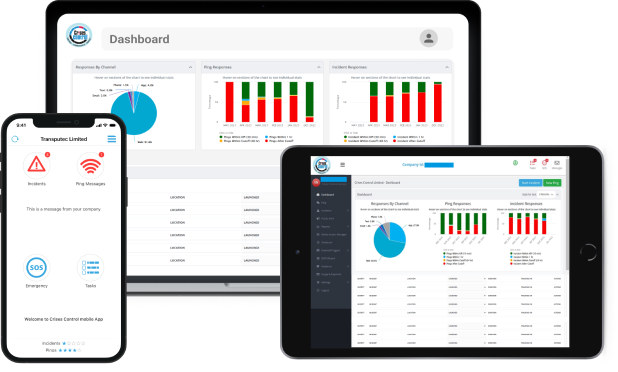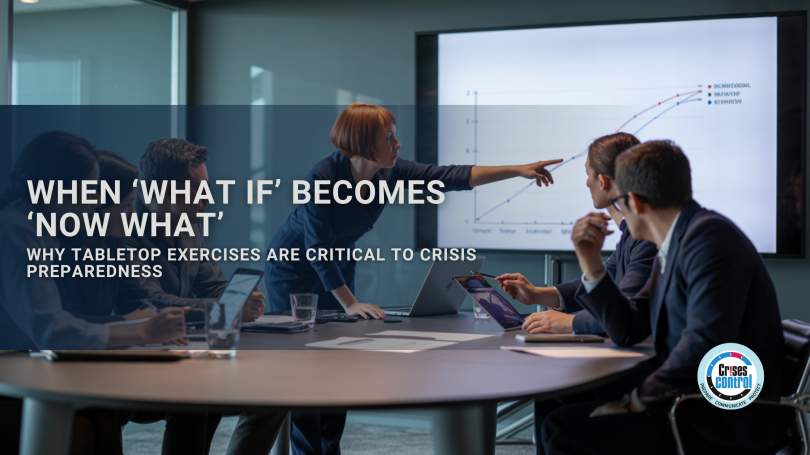Written by Anneri Fourie | Crises Control Executive
Facing the Unknown: Why Plans Alone Aren’t Enough
Imagine a sudden crisis, maybe a cyberattack or a severe storm, that throws your operations into chaos. You have a crisis management plan, but do your teams know how to act when the pressure is on? In many companies, crisis plans are written, filed away, and rarely tested. When the real event hits, decision-makers hesitate, communication breaks down, and valuable time is lost.
The problem is simple. Having a plan on paper is one thing. Knowing how to put it into practice quickly and calmly is quite another.
This is where tabletop exercises come in. They offer a way to rehearse your response in a safe, controlled setting, helping teams move from uncertainty to confident action. This blog will show you why tabletop exercises are a must-have for crisis management and disaster preparedness, explain how to run them effectively, provide practical examples, and demonstrate how Crises Control can make your exercises and real responses far more effective.
The Strategic Power of Simulation: Understanding Tabletop Exercises
Tabletop exercises are structured sessions where key people come together to walk through a realistic crisis scenario. Unlike full-scale drills that involve physical action or technology tests, these exercises focus on discussion and decision-making. They simulate how your organisation would respond if faced with a particular crisis, be it a data breach, supply chain failure, or negative media storm.
But don’t confuse tabletop exercises with mere talk. They expose real weaknesses. They show where communication lines get tangled, where leadership roles are unclear, and where technology might fail in a crisis.
For businesses serious about resilience, tabletop exercises deliver:
- A chance to uncover weaknesses in your plans and communication before they cause trouble
- An opportunity to spot bottlenecks in decision-making and leadership misalignments
- A way to build confidence in key teams so their response becomes instinctive
- A chance to test how your alerting and crisis management systems perform under pressure
In short, tabletop exercises transform a crisis plan from a document on a shelf to a live strategy your teams can rely on.
How to Run Effective Tabletop Exercises for Crisis Management
Conducting tabletop exercises for disaster preparedness isn’t about throwing together random “what if” questions. It requires planning and commitment. Here’s how to approach it so your exercises deliver real insight and practical benefits.
1. Set Clear, Focused Objectives
Start by deciding what you want to learn. Are you checking how quickly your incident alert system works? Testing the speed and clarity of your communication? Or seeing how well your business continuity plans hold up in a supply chain disruption?
Clear goals keep the exercise focused and help you measure success.
2. Pick Scenarios that Matter to Your Business
Generic scenarios don’t engage teams or reveal useful information. Choose risks your organisation actually faces, like a cyberattack on customer data, loss of a critical supplier, or a social media backlash that threatens your brand reputation.
When the scenario feels real, participants take it seriously and provide honest, valuable feedback.
3. Get the Right People in the Room
Crisis response is never the responsibility of a single department. Invite leaders from across your business, including IT, legal, communications, HR, and operations. Bringing diverse perspectives uncovers hidden dependencies and ensures the entire organisation is prepared.
4. Create Real-Time Pressure with Technology
Real crises don’t happen at a leisurely pace. To make your exercise realistic, introduce time pressures, unexpected developments, and the need to send urgent communications.
This is where software like Crises Control comes in handy. You can use the platform to trigger alerts, simulate communications, and send surprise “injects” during the exercise that force teams to adapt on the fly.
5. Review, Learn, and Improve
The real value of tabletop exercises is in what happens afterwards. Hold a thorough debrief to capture lessons learned. Document what worked, what didn’t, and assign follow-up actions to improve your plans and training.
With Crises Control, reporting and audit trails are automated, helping you track improvements over time and demonstrate preparedness to stakeholders.
Business Continuity Tabletop Exercise Examples That Reveal Gaps and Strengths
Here are some practical scenarios you can adapt to your business to make your tabletop exercises more meaningful.
Cyberattack on Customer Data
A ransomware attack locks your customer database. Test your detection speed, legal response, and how well you notify customers and regulators.
Executive Safety Threat During Overseas Travel
A high-profile leader is unreachable amid a security incident abroad. Evaluate how your communication escalates internally, your media response, and coordination with authorities.
Widespread IT System Outage
Your cloud provider experiences downtime during peak trading hours. Check how well your business continuity plan kicks in, internal communications flow, and alternative processes are handled.
Social Media Crisis from Negative Campaign Backlash
Accusations spread rapidly online and hit mainstream media. Test your PR strategy, leadership alignment, and use of alerting tools to manage internal and external messaging.
Each scenario can be made more or less complex depending on your team’s experience and your organisational maturity. Adding Crises Control’s alerting and communication tools simulates the pressure of real time and helps reveal how your systems perform.
Improving Crisis Response with Regular Tabletop Exercises
One-off exercises are useful, but regular practice is what truly builds resilience.
Conducting tabletop exercises on a schedule means you can:
- Track how your response improves over time and measure KPIs like alert speed and communication effectiveness
- Get new team members and leaders up to speed quickly
- Adjust your preparedness to new risks or changes in business strategy
- Build a culture where crisis readiness is a normal part of how your organisation operates
When teams practice regularly, they stop guessing under pressure and start responding with clarity and confidence.
Using Crises Control to Run Effective Tabletop Exercises for Disaster Preparedness
Crises Control is more than an alerting tool. It’s a platform designed to bring your crisis exercises and real incidents to life.
Here is how Crises Control supports you before, during, and after your tabletop exercises:
Before the Exercise
- Create and save realistic crisis scenarios tailored to your organisation
- Schedule exercises and assign clear roles and responsibilities
- Define KPIs such as response time and communication reach using built-in metrics dashboards
During the Exercise
- Trigger incidents through the platform, mimicking real-world alerts
- Monitor communications across multiple channels including email, SMS, phone calls and app notifications
- Track decision timelines and stakeholder engagement, highlighting bottlenecks or confusion
After the Exercise
- Automatically generate audit-ready reports that document performance and lessons learned
- Analyse data to identify trends and areas needing improvement
- Assign corrective actions with follow-up tracking to ensure progress
By integrating Crises Control into your tabletop exercises, you move from passive discussions to dynamic, measurable rehearsals that build confidence and preparedness.
Don’t Just Write Your Crisis Plan. Practise It.
When a real crisis happens, there isn’t time to consult a manual. Tabletop exercises help your organisation move from hesitation to clear, confident action.
With practical scenarios, the right people involved, and the support of tools like Crises Control, you turn theory into muscle memory.
Ready to see how Crises Control can help you conduct powerful tabletop exercises and improve your real-world crisis response?
Experience it first-hand. Book your free demo of Crises Control today.
Request a FREE Demo

